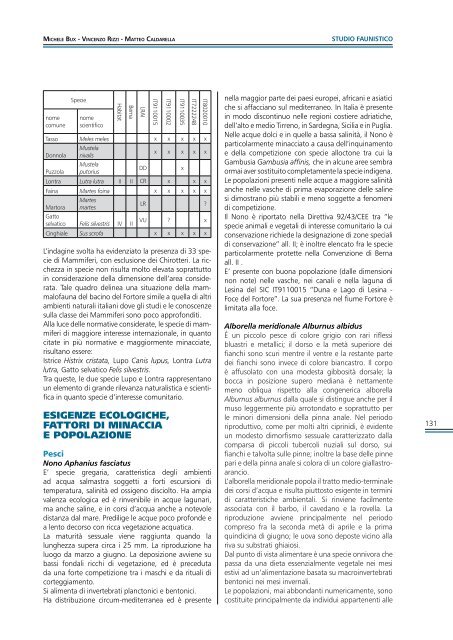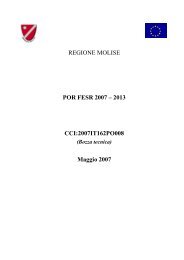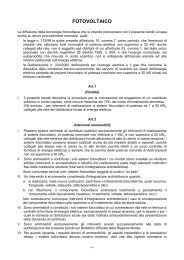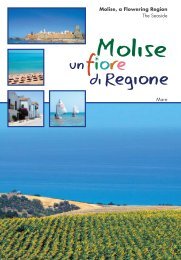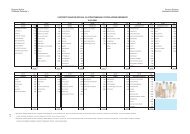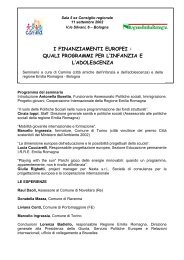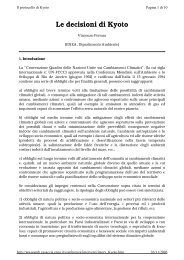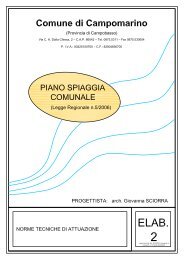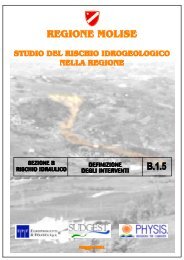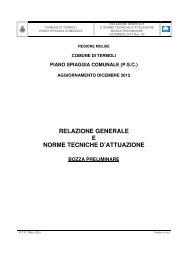Il fiume Fortore - Studi preliminari al piano di gestione dei SIC
Il fiume Fortore - Studi preliminari al piano di gestione dei SIC
Il fiume Fortore - Studi preliminari al piano di gestione dei SIC
Create successful ePaper yourself
Turn your PDF publications into a flip-book with our unique Google optimized e-Paper software.
Mi c he l e Bu x - Vin c e n z o Rizzi - Mat t e o C<strong>al</strong>darella<br />
STUDIO FAUNISTICO<br />
nome<br />
comune<br />
Specie<br />
nome<br />
scientifico<br />
Habitat<br />
Berna<br />
LRAI<br />
IT9110015<br />
IT9110002<br />
IT9110035<br />
IT7222248<br />
Tasso Meles meles x x x x x<br />
Mustela<br />
Donnola niv<strong>al</strong>is<br />
x x x x x<br />
Mustela<br />
Puzzola putorius<br />
DD<br />
x<br />
Lontra Lutra lutra II II CR x x x<br />
Faina Martes foina x x x x x<br />
Martes<br />
Martora martes<br />
LR ?<br />
Gatto<br />
selvatico Felis silvestris IV II<br />
VU ? x<br />
Cinghi<strong>al</strong>e Sus scrofa x x x x x<br />
IT8020010<br />
L’indagine svolta ha evidenziato la presenza <strong>di</strong> 33 specie<br />
<strong>di</strong> Mammiferi, con esclusione <strong>dei</strong> Chirotteri. La ricchezza<br />
in specie non risulta molto elevata soprattutto<br />
in considerazione della <strong>di</strong>mensione dell’area considerata.<br />
T<strong>al</strong>e quadro delinea una situazione della mamm<strong>al</strong>ofauna<br />
del bacino del <strong>Fortore</strong> simile a quella <strong>di</strong> <strong>al</strong>tri<br />
ambienti natur<strong>al</strong>i it<strong>al</strong>iani dove gli stu<strong>di</strong> e le conoscenze<br />
sulla classe <strong>dei</strong> Mammiferi sono poco approfon<strong>di</strong>ti.<br />
Alla luce delle normative considerate, le specie <strong>di</strong> mammiferi<br />
<strong>di</strong> maggiore interesse internazion<strong>al</strong>e, in quanto<br />
citate in più normative e maggiormente minacciate,<br />
risultano essere:<br />
Istrice Histrix cristata, Lupo Canis lupus, Lontra Lutra<br />
lutra, Gatto selvatico Felis silvestris.<br />
Tra queste, le due specie Lupo e Lontra rappresentano<br />
un elemento <strong>di</strong> grande rilevanza natur<strong>al</strong>istica e scientifica<br />
in quanto specie d’interesse comunitario.<br />
esigenze ecologiche,<br />
fattori <strong>di</strong> minaccia<br />
e popolazione<br />
Pesci<br />
Nono Aphanius fasciatus<br />
E’ specie gregaria, caratteristica degli ambienti<br />
ad acqua s<strong>al</strong>mastra soggetti a forti escursioni <strong>di</strong><br />
temperatura, s<strong>al</strong>inità ed ossigeno <strong>di</strong>sciolto. Ha ampia<br />
v<strong>al</strong>enza ecologica ed è rinvenibile in acque lagunari,<br />
ma anche s<strong>al</strong>ine, e in corsi d’acqua anche a notevole<br />
<strong>di</strong>stanza d<strong>al</strong> mare. Pre<strong>di</strong>lige le acque poco profonde e<br />
a lento decorso con ricca vegetazione acquatica.<br />
La maturità sessu<strong>al</strong>e viene raggiunta quando la<br />
lunghezza supera circa i 25 mm. La riproduzione ha<br />
luogo da marzo a giugno. La deposizione avviene su<br />
bassi fond<strong>al</strong>i ricchi <strong>di</strong> vegetazione, ed è preceduta<br />
da una forte competizione tra i maschi e da ritu<strong>al</strong>i <strong>di</strong><br />
corteggiamento.<br />
Si <strong>al</strong>imenta <strong>di</strong> invertebrati planctonici e bentonici.<br />
Ha <strong>di</strong>stribuzione circum-me<strong>di</strong>terranea ed è presente<br />
nella maggior parte <strong>dei</strong> paesi europei, africani e asiatici<br />
che si affacciano sul me<strong>di</strong>terraneo. In It<strong>al</strong>ia è presente<br />
in modo <strong>di</strong>scontinuo nelle regioni costiere adriatiche,<br />
dell’<strong>al</strong>to e me<strong>di</strong>o Tirreno, in Sardegna, Sicilia e in Puglia.<br />
Nelle acque dolci e in quelle a bassa s<strong>al</strong>inità, il Nono è<br />
particolarmente minacciato a causa dell’inquinamento<br />
e della competizione con specie <strong>al</strong>loctone tra cui la<br />
Gambusia Gambusia affinis, che in <strong>al</strong>cune aree sembra<br />
ormai aver sostituito completamente la specie in<strong>di</strong>gena.<br />
Le popolazioni presenti nelle acque a maggiore s<strong>al</strong>inità<br />
anche nelle vasche <strong>di</strong> prima evaporazione delle s<strong>al</strong>ine<br />
si <strong>di</strong>mostrano più stabili e meno soggette a fenomeni<br />
<strong>di</strong> competizione.<br />
<strong>Il</strong> Nono è riportato nella Direttiva 92/43/CEE tra “le<br />
specie anim<strong>al</strong>i e veget<strong>al</strong>i <strong>di</strong> interesse comunitario la cui<br />
conservazione richiede la designazione <strong>di</strong> zone speci<strong>al</strong>i<br />
<strong>di</strong> conservazione” <strong>al</strong>l. II; è inoltre elencato fra le specie<br />
particolarmente protette nella Convenzione <strong>di</strong> Berna<br />
<strong>al</strong>l. II .<br />
E’ presente con buona popolazione (d<strong>al</strong>le <strong>di</strong>mensioni<br />
non note) nelle vasche, nei can<strong>al</strong>i e nella laguna <strong>di</strong><br />
Lesina del <strong>SIC</strong> IT9110015 “Duna e Lago <strong>di</strong> Lesina -<br />
Foce del <strong>Fortore</strong>”. La sua presenza nel <strong>fiume</strong> <strong>Fortore</strong> è<br />
limitata <strong>al</strong>la foce.<br />
Alborella meri<strong>di</strong>on<strong>al</strong>e Alburnus <strong>al</strong>bidus<br />
É un piccolo pesce <strong>di</strong> colore grigio con rari riflessi<br />
bluastri e met<strong>al</strong>lici; il dorso e la metà superiore <strong>dei</strong><br />
fianchi sono scuri mentre il ventre e la restante parte<br />
<strong>dei</strong> fianchi sono invece <strong>di</strong> colore biancastro. <strong>Il</strong> corpo<br />
è affusolato con una modesta gibbosità dors<strong>al</strong>e; la<br />
bocca in posizione supero me<strong>di</strong>ana è nettamente<br />
meno obliqua rispetto <strong>al</strong>la congenerica <strong>al</strong>borella<br />
Alburnus <strong>al</strong>burnus d<strong>al</strong>la qu<strong>al</strong>e si <strong>di</strong>stingue anche per il<br />
muso leggermente più arrotondato e soprattutto per<br />
le minori <strong>di</strong>mensioni della pinna an<strong>al</strong>e. Nel periodo<br />
riproduttivo, come per molti <strong>al</strong>tri ciprini<strong>di</strong>, è evidente<br />
un modesto <strong>di</strong>morfismo sessu<strong>al</strong>e caratterizzato d<strong>al</strong>la<br />
comparsa <strong>di</strong> piccoli tubercoli nuzi<strong>al</strong>i sul dorso, sui<br />
fianchi e t<strong>al</strong>volta sulle pinne; inoltre la base delle pinne<br />
pari e della pinna an<strong>al</strong>e si colora <strong>di</strong> un colore gi<strong>al</strong>lastroarancio.<br />
L’<strong>al</strong>borella meri<strong>di</strong>on<strong>al</strong>e popola il tratto me<strong>di</strong>o-termin<strong>al</strong>e<br />
<strong>dei</strong> corsi d’acqua e risulta piuttosto esigente in termini<br />
<strong>di</strong> caratteristiche ambient<strong>al</strong>i. Si rinviene facilmente<br />
associata con il barbo, il cavedano e la rovella. La<br />
riproduzione avviene princip<strong>al</strong>mente nel periodo<br />
compreso fra la seconda metà <strong>di</strong> aprile e la prima<br />
quin<strong>di</strong>cina <strong>di</strong> giugno; le uova sono deposte vicino <strong>al</strong>la<br />
riva su substrati ghiaiosi.<br />
D<strong>al</strong> punto <strong>di</strong> vista <strong>al</strong>imentare è una specie onnivora che<br />
passa da una <strong>di</strong>eta essenzi<strong>al</strong>mente veget<strong>al</strong>e nei mesi<br />
estivi ad un’<strong>al</strong>imentazione basata su macroinvertebrati<br />
bentonici nei mesi invern<strong>al</strong>i.<br />
Le popolazioni, mai abbondanti numericamente, sono<br />
costituite princip<strong>al</strong>mente da in<strong>di</strong>vidui appartenenti <strong>al</strong>le<br />
131


